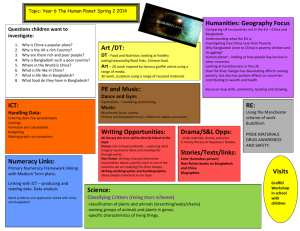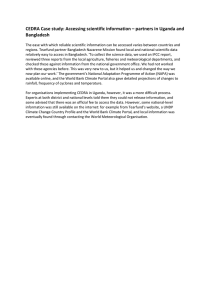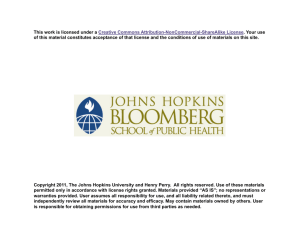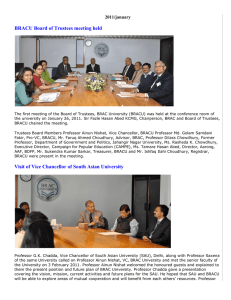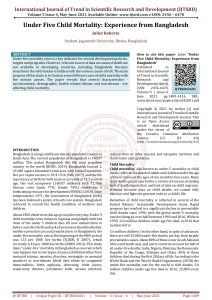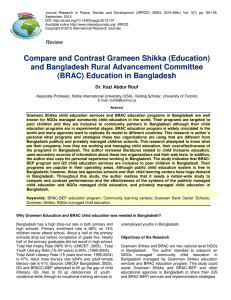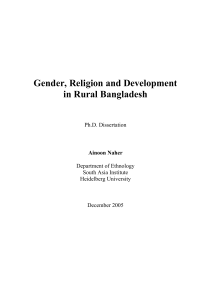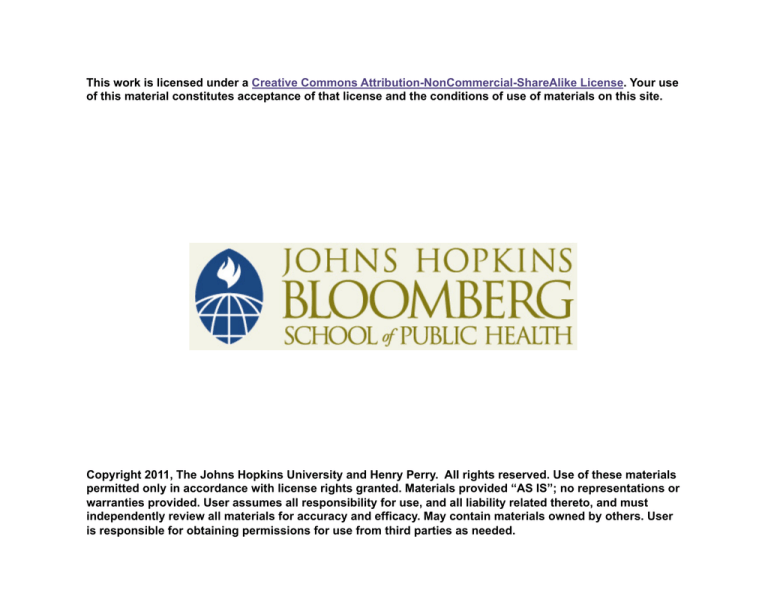
This work is licensed under a Creative Commons Attribution-NonCommercial-ShareAlike License. Your use
of this material constitutes acceptance of that license and the conditions of use of materials on this site.
Copyright 2011, The Johns Hopkins University and Henry Perry. All rights reserved. Use of these materials
permitted only in accordance with license rights granted. Materials provided “AS IS”; no representations or
warranties provided. User assumes all responsibility for use, and all liability related thereto, and must
independently review all materials for accuracy and efficacy. May contain materials owned by others. User
is responsible for obtaining permissions for use from third parties as needed.
Bangladesh and BRAC
Henry Perry, MD, PhD, MPH
Johns Hopkins University
Section A
Bangladesh
The Power of Positive Deviance
4
www.positivedeviance.org
Positive Deviance Initiative
Tufts University
Friedman School of Nutrition Science and Policy
150 Harrison Avenue
Boston, MA 02111
5
Outline
Overview of Bangladesh and health
Development of primary health care services
Importance of community-based services
BRAC and its integrated development programs
BRAC’s primary health care programs
BRAC’s urban maternal, neonatal, and child health program
Summary and conclusion
6
Bangladesh
7
Heath For All in Bangladesh
8
Three Pillars of Alma Ata
1. Extension of facilities and effective and affordable services as
close as possible to where people live
2. Genuine community participation
3. Inter-sectoral cooperation
9
Medicine in the 20th Century
“If I were asked to compose an epitaph on medicine
throughout the 20th century, it would read:
Brilliant in its scientific discoveries, superb in its
technological breakthroughs, but woefully inept in
its application to those most in need”
—N.R.E. Fendall (1972)
10
The 20th Century
The 20th century will be chiefly remembered in
future centuries not as an age of political conflicts
or technical inventions, but as an age in which
human society dared to think of the welfare of the
whole human race as a practical objective.
—Arnold Toynbee (quoted in Unicef, 1995)
11
Bangladesh at a Glance
Area (sq. km): 147,570
Population: 144 million
GNP per capita: 440 USD
Per capita health expenditure: 12 USD
Life expectancy: 63.3 years
Population living below $1 per day: 36%
Source: (2006). UNDP Human Development Report.
12
“Recent” History of Bangladesh
Fertile farmland with dense population
Partition in 1947: East and West Pakistan
War of Independence
Situation in 1970 similar to Afghanistan’s today
13
Health Scenario
Bangladesh has considerably improved health status over the last
few decades
- NGOs working side by side with the government have
contributed significantly
Indicators
1970s
2007
Total fertility rate
6.3
2.7
Immunization coverage
2%
82%
Under-five mortality rate (per 1,000 live births)
221
65
Maternal mortality ratio (per 100,000 live births)
750
322
700 (est.)
400
Prevalence of tuberculosis
Source: BFS 1975, BMHSMS 2001, BDHS 2007.
14
Countries with a Per Capita GNP of US$ 250 or Less
15
Contraceptive Use, Bangladesh
16
Health Expenditures
17
Millennium Development Goal 4
Reducing under-five mortality
18
Millennium Development Goal 4
Progress in Bangladesh in Achieving Millennium Development Goal 4
Source: WHO and UNICEF. (2010). Countdown to 2015: Maternal, Newborn and Child Survival.
19
Millennium Development Goal 4
Bangladesh is one of only 19 out of 68 countries (that have 97% of
the world’s under-five deaths) on track to achieve MDG 4
20
Current National Health Statistics
Infant mortality rate: 52/1000
Under-five mortality rate: 65/1000
Percentage of under-five children stunted: 43%
Total fertility rate: 2.7
Contraceptive prevalence rate (% of married women using
contraception): 56%
21
Historical Factors
ORS/Matlab MCH-FP Project/ICDDR,B
Bifurcation of MOH with targeted funding for family planning
22
Historical Factors
Scaling-up of evidence-based family planning intervention
Reliance on home visitation for providing family planning motivation
and distribution of birth control pills and condoms
Strong national EPI, diarrhea, TB programs
23
Historical Factors
Strong NGO programs—such as BRAC
Policy-friendly environment for NGOs
24




